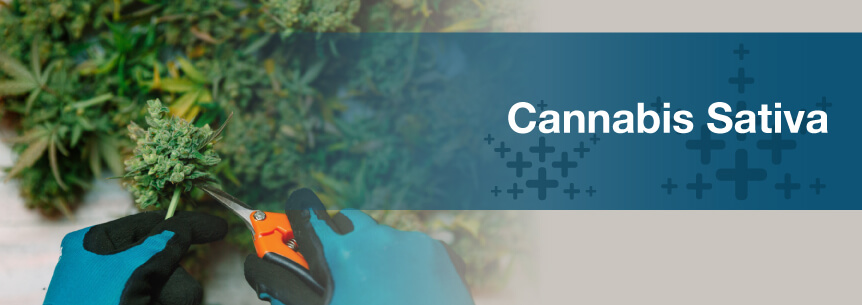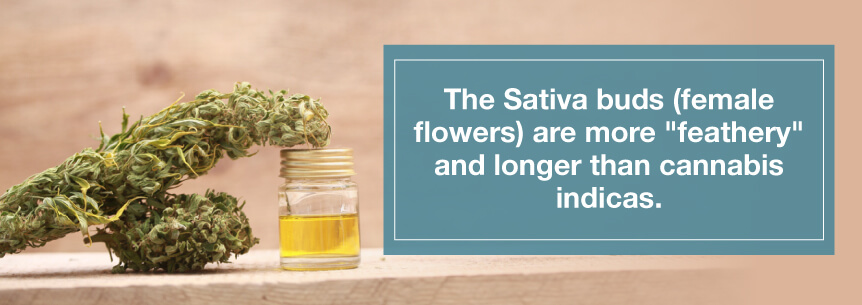
If you’re just getting started in the world of medical marijuana, even walking into a dispensary can cause overwhelming uncertainty. You’ll see an array of different products and boards listing various marijuana strain names you don’t recognize, and you’ll likely have a lot of questions.
For instance, what is sativa?
What are sativa’s effects?
And how are those effects different from indica?
We’ll answer all of those questions and more in this guide.
The effects of cannabis vary from strain to strain, so it’s important to know what you’re getting into before you try one. Whereas indica will likely make you feel calm and sedated, sativa is known for its upbeat, energizing effects.
If you talk to a budtender about the effects of sativa, they will likely use some of the following phrases to describe it:
Many people compare taking a dose of cannabis sativa to drinking a cup of coffee. Different strains have different amounts of THC and other chemical compounds that impact their effects, but most sativa strains will give you an upbeat “head high.”
This is very different from indica, which is known for its sedative, relaxing “body high.”. You can read more about the difference between these two types of cannabis in our indica vs. sativa article.
Now that we’ve discussed sativa’s effects, let’s talk more broadly about its benefits, side effects, and other related topics.
Cannabis sativa is one of the two primary types of cannabis plant, the other being cannabis indica. The two plants differ in several ways. For instance, they have different leaf shapes and chemical profiles, and they have drastically different effects.
When used for medical purposes, sativa tends to make the user feel uplifted, cerebral, creative, and productive. As we discussed above, this is very different from indica, which tends to make the user feel calm and relaxed.
Cannabis sativa originated in the warm climates of Central and Southeast Asia (think Pakistan, Afghanistan, Nepal, and Vietnam), but today it’s cultivated all over the world.
Every marijuana strain has a different chemical makeup. Most notably, they all have different amounts of tetrahydrocannabinol (THC) and cannabidiol (CBD).
This is important to understand because these chemical compounds are responsible for different effects. Choosing the right strain will give you your desired effect.
Here’s what we mean:
Tetrahydrocannabinol (THC) is a cannabinoid that produces psychoactive effects. Sativa strains tend to have high THC content, which is why sativa cannabis products are known for producing a more “cerebral” high.
Cannabidiol (CBD), on the other hand, is a non-psychoactive compound that produces a slower, more relaxing effect when inhaled or ingested. It’s no surprise, then, that the indica plant has a high CBD content while sativa doesn’t not.
Again, that’s why medical marijuana users typically choose sativa strains when they want to feel upbeat and indica strains when they want to relax.

Sativa strains help you to think creatively and to analyze your human experience — probably why it’s a favored strain among artists, musicians, and philosophers. Some sativa strains seem to enhance light and sound, which can make movies, music, and other surroundings more vibrant.
Researchers are continuously studying the sativa plant as a potential treatment for many medical conditions, including:
The most substantial benefits are those used in treating multiple sclerosis and chronic pain. Cannabis also helps reduce eye pressure in glaucoma patients.
Many individuals report sativas help to:
Other sativa benefits include:
Many individuals take sativa strains to manage mental and behavioral problems like depression and ADHD. Like indica, it can also increase the user’s appetite, making it extremely useful if you receive a diagnosis of anorexia, cancer, or HIV/AIDS.
Cannabis sativa typically only produces a mild high. It makes you feel cerebral, creative, energetic, and giggly. Its effects are less overpowering than indica’s effects.
However, some users do report experiences of the following:
Therefore, if you suffer from social anxiety (or any other type of anxiety), you may want to avoid these strains.
Also, it’s worth noting that cannabis, in general, is known to cause dry mouth, so keep a bottle of water handy when you’re using it.
What Are the Best Strains of Cannabis Sativa?
There are many sativa strains out there to experiment with. Here are some of the most popular strains:
Blue Dream, White Widow, Jack Herer, and Silver Haze are also sativa strains that are popular among medical cannabis users.
Aside from feeling its effects, you can recognize sativa in a few ways, primarily by looking at its buds and smelling its aroma.
We’ll offer more information to help you identify sativa in the subsections below:

Sativa’s “buds,” or female flowers, have a fluffy, almost feathery appearance that differentiates them from cannabis indica buds. Unlike indica’s tight, chunky flowers, sativa flowers are typically very loose and stretched out. Many individuals refer to them as “Grinch fingers” due to their slender shape and their hairy-looking exterior.
Cannabis sativa’s female flowers begin at the points where pairs of leaves grow from the branches and stem (nodes). Flowers typically grow out along the length of the plant, rather than grouping up around the nodes as other cannabis types do. This formation is due to sativa’s tendency to flower and grow simultaneously. Because of this, the female flowers of the sativa plant weigh less and are less dense than indica flowers, regardless of their being larger or equal in size.
Indica flowers tend to group up around the nodes, since the plant has already stopped growing once it reaches the flowering period. This is why indica flowers tend to be smaller and denser than the spindly and light flowers of the sativa plant.
Sativa strains have a larger quantity of myrcene, terpinolene, and other terpenes, causing them to have a delicate and floral aroma. They can be very pungent smelling, but overall their aromas range from fruity and sweet to earthy with diesel fuel undertones.
Various favored strains have similar peppery and sweet aromas classic to sativa. These strains are just a few examples:
While some strains, like Trainwreck, are more peppery, Cherry AK and others are more on the sweet-smelling side. Even though these strains all provide similar effects, they have distinct aromas due to their unique terpene profiles.
After you get to know all the various terpenes in medical weed, it’s relatively simple to detect the strain you’re using just by its scent alone. To the trained nose, sativas are easily discernible.
There are many ways to administer cannabis for medical use. Here are some of the most popular options:
If, after learning about cannabis sativa, you feel you need more information or are ready to give it a try, we can help. You can search for a medical marijuana doctor and find a dispensary on our website, MarijuanaDoctors.com.
We also have professionals who can answer your questions, provide recommendations, and connect you with qualified doctors to get you started on your medical cannabis treatment. Contact us today!